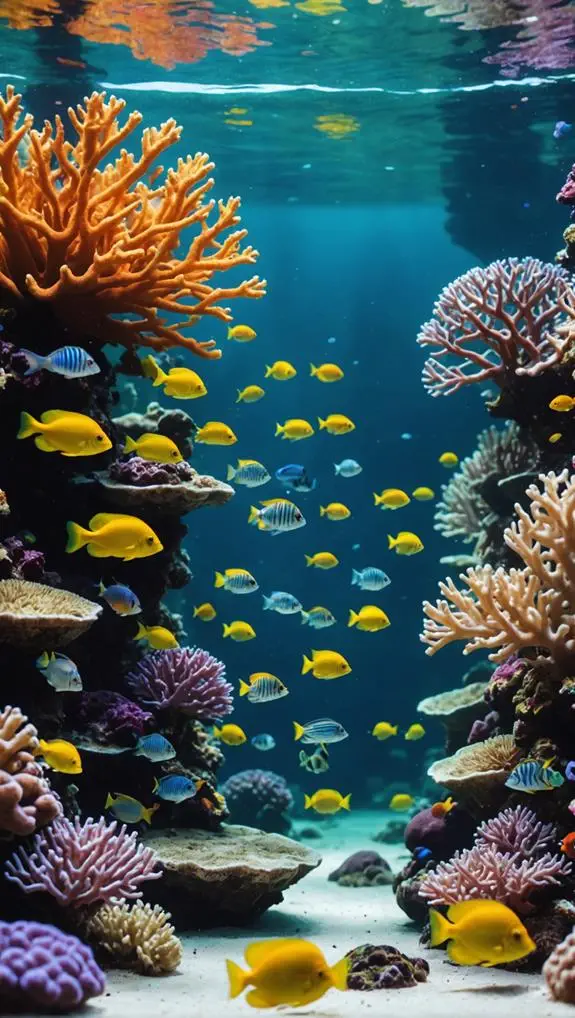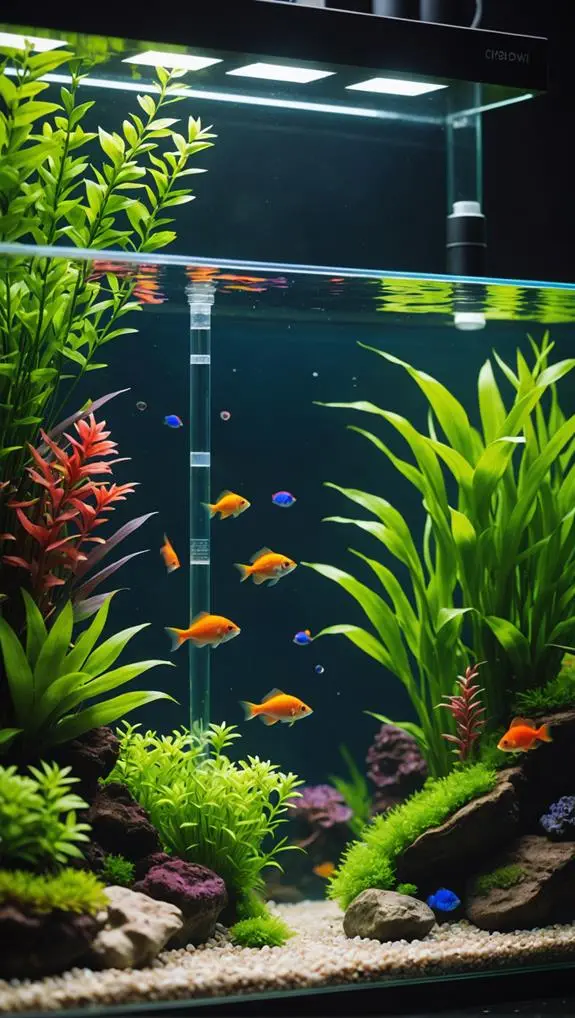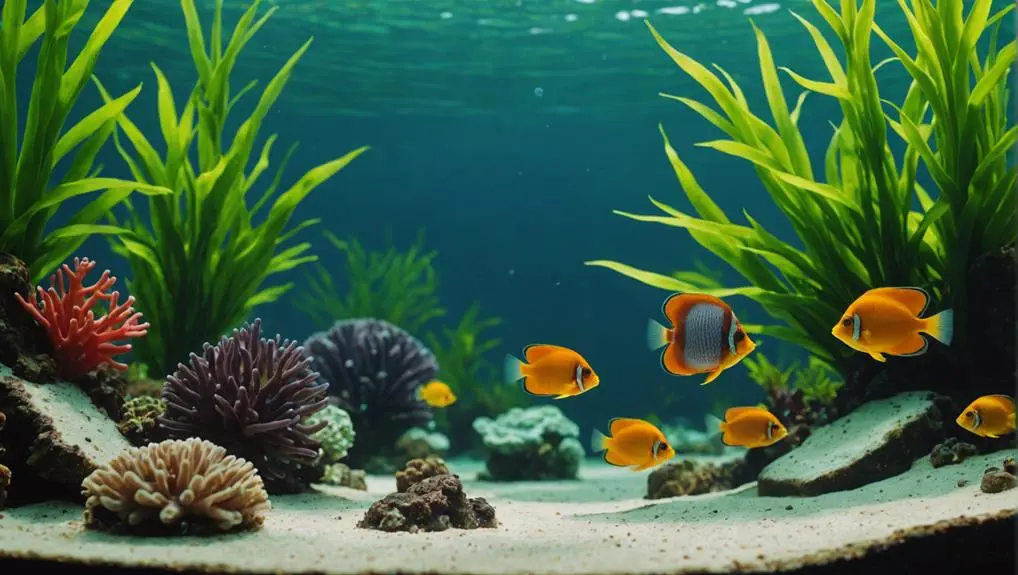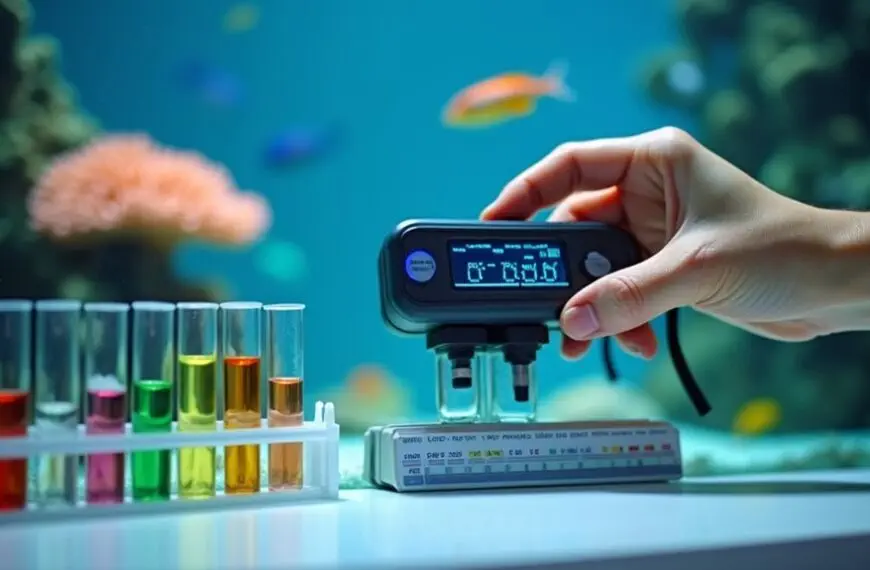pH levels are super important for your fish tank's health. They affect how your fish grow, behave, and even get along with their tank buddies! Most freshwater fish love a pH between 6.5 and 8.5, but some species, like African cichlids, require a bit more alkaline loving; they thrive at 8.0 to 9.0. Keeping pH stable prevents stress, which can lead to all sorts of fishy problems, like loss of appetite and bad gill health. So, grab a testing kit to keep tabs on things, and you'll be well on your way to a happy underwater world. Curious to learn more tricks?
Contents
- 1 Understanding Ph and Its Importance
- 2 Effects of Ph on Aquatic Life
- 3 Optimal Ph Ranges for Fish Species
- 4 Common Ph Imbalance Issues
- 5 Monitoring Ph Levels Effectively
- 6 Techniques for Stabilizing Ph
- 7 Recommended Products for Ph Management
- 8 Addressing Reader Concerns on Ph
- 9 Frequently Asked Questions
- 10 Final Thoughts
Understanding Ph and Its Importance
Understanding pH and its importance is essential for maintaining a healthy fish tank. pH measures the concentration of hydrogen ions in water, and most freshwater fish thrive in a range between 6.5 and 8.5. Keeping a stable pH is key to your fish's well-being.
When the pH fluctuates, it can lead to increased ammonia toxicity, which isn't a fun surprise for your aquatic friends. Some species, like cichlids from the African Rift Lakes, even require a specific pH of 8.0 to 9.0. So, knowing your fish's needs is crucial!
Regular pH testing helps you keep track of water chemistry and prevent those pesky shifts that can stress your fish, leading to lethargy or even color changes. Imagine your fish feeling like they're on a roller coaster – not exactly the calm environment you want to create!
Effects of Ph on Aquatic Life
Often overlooked, pH levels play a crucial role in the health of aquatic life. Maintaining the right pH is essential for your fishy friends. Did you know that even a tiny change in pH can lead to significant stress for your fish? You might be surprised how much it affects their well-being!
Here are three key effects of pH on aquatic life:
- Stress Levels: Abnormal pH can cause lethargy, reduced appetite, and make fish more prone to diseases. It's like a bad day at work — nobody wants that!
- Ammonia Toxicity: Lower pH levels can increase ammonia toxicity, which is especially dangerous during the cycling process of your aquarium. Think of it as a toxic cloud that your fish can't escape.
- Species-Specific Needs: Different fish species have unique pH preferences. For instance, cichlids thrive at 8.0–9.0, while cardinal tetras prefer below 5.5. Knowing these needs is key for good water quality.
Regular pH testing is vital to ensure a healthy environment for your aquatic life.
Optimal Ph Ranges for Fish Species

Finding the right pH balance is essential for keeping your fish healthy and thriving. Most freshwater tropical fish enjoy optimal pH ranges between 6.5 and 7.5. This sweet spot helps them grow strong and stay vibrant.
However, if you're considering African cichlids, be prepared for some high pH levels! They need between 8.0 and 9.0 to feel at home.
On the other hand, if your heart is set on acid-loving species like cardinal tetras, you'll want to keep the pH below 5.5. They appreciate those low pH conditions, which are crucial for their wellbeing and reproduction.
And let's not forget about discus! These beauties thrive best in a pH range of 5.5 to 7.5, with lower pH levels helping those tiny embryos survive during breeding.
Common Ph Imbalance Issues
pH imbalance can wreak havoc in your aquarium, causing stress and health issues for your fish. Keeping an eye on the pH in your aquarium is crucial.
Some common pH imbalance issues include:
- High pH levels: Often caused by overfeeding and decaying organic matter, high pH can lead to elevated ammonia toxicity, stressing out your fish. If the pH exceeds 8.5, your freshwater species might suffer from poor digestion and damaged gills.
- Low pH: Symptoms include lethargy, reduced appetite, and heightened fish stress. You might notice your fish just hanging around, looking a bit down.
- Minor shifts in pH: It's surprising how just a one-unit change in pH can create a tenfold change in hydrogen ion concentration, dramatically affecting your aquatic life.
Regular water quality checks and maintenance are vital. You can lower the pH if it's too high, or take steps to stabilize it.
With proper pH in your aquarium, your fish will thrive, and you'll enjoy a vibrant underwater world. Happy fishkeeping!
Monitoring Ph Levels Effectively

Maintaining a healthy aquarium environment hinges on effective pH level monitoring. You want to keep an eye on your water pH, as most freshwater fish thrive within a range of 6.5 to 8.5. Deviations can lead to stress and health issues for your aquatic friends.
It's essential to use reliable methods, like pH meters, for accurate measurements. Traditional testing strips can be a bit tricky, as they're subject to interpretation and contamination.
Daily monitoring is key since pH levels can fluctuate due to hydrogen ions from carbon dioxide, organic matter decay, or even changes in your water source.
Don't forget to implement a regular water change routine! This helps manage pH levels naturally while reducing organic waste.
You can also use pH buffers and conditioners to fine-tune your levels. This ensures your fish are swimming happily in the ideal conditions.
Remember, happy fish equal a happy you! So, grab your pH meter, and let's keep those fish healthy and thriving.
Your commitment makes all the difference, and your fish will thank you—though they mightn't say it out loud!
Techniques for Stabilizing Ph
Stability in your aquarium's environment is crucial for the health and happiness of your fish. To help keep that pH steady and avoid any nasty surprises, consider these techniques:
- Regular Water Changes: Conduct partial water changes to remove organic matter that can cause pH fluctuations. Even a little fresh water goes a long way!
- Use Mineral Buffers: These nifty products can help maintain your desired pH range. They neutralize acids or bases that sneak into your tank, keeping things balanced.
- Monitor CO2 Levels: High CO2 levels can drop your pH, so keep an eye on it. Adding live plants or using an aeration system can really help regulate those levels.
Don't forget about alkalinity (KH), either. Low KH can lead to unstable pH, which isn't what you want for your fishy friends.
If you're looking to lower pH, driftwood or peat moss can help, but be careful! Always monitor those changes closely to avoid shocking your aquatic buddies.
With these techniques, you'll create a stable and nurturing environment for your fish to thrive!
Recommended Products for Ph Management

To keep your fish tank happy and healthy, you'll want to start with some essential testing kits that can give you accurate readings on your pH levels.
These handy tools help you monitor the water conditions, making sure your fish aren't swimming in a toxic soup.
Plus, effective water conditioners can stabilize those pH levels right after a water change, reducing stress for your aquatic pals—because nobody likes a rollercoaster ride in their home!
Essential Testing Kits
Accurate pH testing is crucial for ensuring your fish tank remains a thriving ecosystem. Without it, you could be swimming in trouble!
Regular monitoring of your aquarium water is essential to keep those hydrogen ions in check and maintain the ideal pH range of 6.5 to 8.5 for your fish.
Here are three essential pH test kits to help you out:
- Checker Plus pH Tester: This electronic meter makes it super easy to get precise measurements. You won't have to squint at color charts anymore!
- HALO Wireless pH Meter: Team this up with the Hanna Lab App to log your data and automatically calibrate your readings. It's like having a personal assistant for your tank!
- pH Test Strips: If you're looking for something quick and simple, these strips can be a handy tool for a fast check on your water's acidity or alkalinity.
Don't forget to use mineral buffers alongside your pH test kits. They help stabilize your tank's pH levels, ensuring a safe and welcoming environment for your aquatic friends.
Happy testing!
Effective Water Conditioners
Maintaining the right pH level in your aquarium goes hand in hand with using effective water conditioners. These products play a crucial role in stabilizing pH levels and improving overall water quality, making your aquarium a happy home for fish and plants alike.
Many water conditioners contain mineral buffers that help you achieve those specific pH ranges needed for certain species.
Think of pH stabilizers as your aquarium's superhero, ready to swoop in and counteract those pesky fluctuations caused by organic material breakdown or rising carbon dioxide levels.
Regularly using these conditioners can prevent pH swings that stress your aquatic life, leading to a more vibrant and thriving environment. After all, happy fish make for a healthy aquarium!
When you're choosing water conditioners, make sure to pick ones designed specifically for aquarium use.
Whether you have freshwater or saltwater, compatibility is key.
Addressing Reader Concerns on Ph
Understanding pH levels in your fish tank is crucial for maintaining a healthy environment for your aquatic pets. Many readers worry about how tap water pH can vary and how it might impact fish health.
It's super important to test your water before adding new sources to your aquarium. Here are three key points to consider:
- Acclimatization: Fish can adjust to pH changes, but it's best to acclimate them gradually. This helps reduce stress and keeps your finned friends happy!
- Adaptability: You might think fish need to stay in their native pH environments, but many can thrive in a wider range than you'd expect.
- Automated Solutions: Continuous drip systems can help maintain stable pH levels, making your aquarium care a bit easier.
Using test kits will help you keep a close eye on your water quality.
Remember, although pH is important, your fish are resilient and can adapt to different conditions.
With a little patience and care, you'll be creating a thriving underwater paradise for your fish in no time!
Frequently Asked Questions
Does Ph Really Matter in an Aquarium?
Yes, pH really matters in your aquarium. It affects aquarium balance, influences fish species' health, and ensures proper water chemistry. Maintaining ideal levels aids tank filtration, meets habitat requirements, and aids in disease prevention for your fish.
What Happens if Ph Is Too High in a Fish Tank?
If your fish tank's pH is too high, you'll see increased fish stress, algae growth, and disease susceptibility. Breeding issues and chemical instability can arise, jeopardizing the health of your aquatic friends. Regular monitoring's crucial!
What Ph Level Should Fish Be Healthy?
For healthy fish, aim for the ideal pH range of 6.5 to 8.5. Use reliable test kits, understand species-specific needs, and employ pH adjustment methods while debunking common misconceptions about buffering capacity.
Why Is Ph Important in Tanks?
Think of pH as the heartbeat of your tank; it ensures pH stability for freshwater species and aquatic plants. Regular testing frequency maintains water chemistry, enhancing fish compatibility and creating a thriving environment for all.
Final Thoughts
Keeping an eye on your fish tank's pH levels isn't just a chore—it's a key part of keeping your aquatic friends happy and healthy. Remember, different fish have different needs, and a little effort goes a long way in creating a thriving underwater world. So, grab those test strips, make adjustments as needed, and watch your fish flourish. After all, a happy fish is a swimming fish, and who doesn't love a lively aquarium? Happy fishkeeping!












